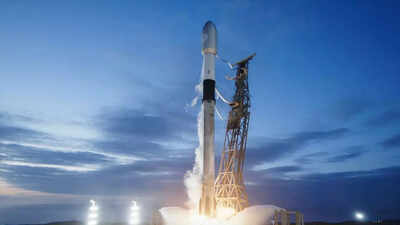
On Sunday, September 28, 2025, SpaceX launched 28 Starlink satellites into low Earth orbit from Vandenberg Space Force Base in Southern California. The Falcon 9 rocket’s ascent lit up the evening sky, creating a striking spectacle for viewers across the region. This mission, part of Starlink Group 11-20, adds to SpaceX’s ever-growing megaconstellation, which now comprises more than 8,500 active satellites. These satellites work together to provide high-speed, low-latency broadband internet around the world, including in remote and underserved areas. The launch underscores SpaceX’s continued advancements in reusable rocket technology, satellite deployment, and global connectivity, further solidifying its role as a leading force in the commercial space and broadband sectors.
SpaceX Falcon 9 launch from Vandenberg deploys Starlink satellites into low Earth orbit
The Falcon 9 rocket lifted off at 10:04 p.m. EDT (7:04 p.m. PDT), reaching orbit in under ten minutes. The upper stage of the rocket carried the Starlink satellites and was scheduled to deploy them approximately one hour after launch. This precise timing ensures the satellites reach their designated orbital slots, optimizing coverage for end users.The liftoff window had been scheduled from 6:28 p.m. to 8:32 p.m. PT, highlighting the flexibility of launch scheduling, which accounts for potential weather changes, technical delays, or other unforeseen factors. SpaceX also streamed the event live via a webcast, allowing the public to witness the mission in real time.
SpaceX Falcon 9 booster 1063 lands smoothly adding to reusable rocket successes
The first stage of the Falcon 9 rocket, Booster 1063, completed its 28th flight, demonstrating SpaceX’s reusable rocket technology in action. After separation, the booster executed a flawless propulsive landing on the droneship Of Course I Still Love You, stationed in the Pacific Ocean.Booster 1063 has previously supported multiple high-profile missions, including Sentinel-6 Michael Freilich, DART, Transporter-7, Iridium, and other Starlink deployments. The ability to reuse rockets multiple times significantly reduces launch costs and environmental impact, marking a revolutionary approach in modern aerospace engineering.
What makes Falcon 9 unique
Falcon 9 is a two-stage, orbital-class reusable rocket developed by SpaceX. Its design focuses on reliability, safety, and cost-effectiveness. The rocket is capable of transporting payloads, crewed missions, and satellites into orbit while enabling rapid reuse of its first stage. This breakthrough technology has positioned SpaceX as a leader in the commercial space industry and has paved the way for frequent and economical launches.Starlink is SpaceX’s satellite internet initiative, designed to deliver broadband connectivity to remote and underserved areas. The satellites orbit at approximately 550 km (342 miles) above Earth, communicating with ground antennas installed at users’ homes. This network supports streaming, online gaming, video calls, and other high-bandwidth applications.By continually launching new satellites, SpaceX aims to enhance network coverage, reduce latency, and improve internet reliability worldwide, making Starlink a key player in the global broadband ecosystem.
SpaceX Falcon 9 milestones highlight reusable rockets and expanding Starlink constellation
The September 28 launch marked SpaceX’s 124th Falcon 9 mission of 2025 and the company’s 542nd overall launch since 2010. These milestones underscore SpaceX’s role in the rapidly growing satellite deployment and commercial space market, demonstrating both technical expertise and operational scale unmatched by other private aerospace companies.Each successful Falcon 9 mission validates SpaceX’s reusability model, proving that rockets can withstand repeated flights while maintaining performance and safety. The Starlink constellation continues to grow, offering high-speed, low-latency internet across the globe and supporting critical applications in education, commerce, and disaster response.The combination of reusable rockets and satellite constellations represents a transformative shift in how humanity accesses space and digital infrastructure. SpaceX’s approach could redefine global internet accessibility while reducing the costs and environmental footprint associated with space launches.Also Read | NASA’s Artemis II mission: Orion spacecraft ‘Integrity’ named ahead of historic lunar flight in February 2026







